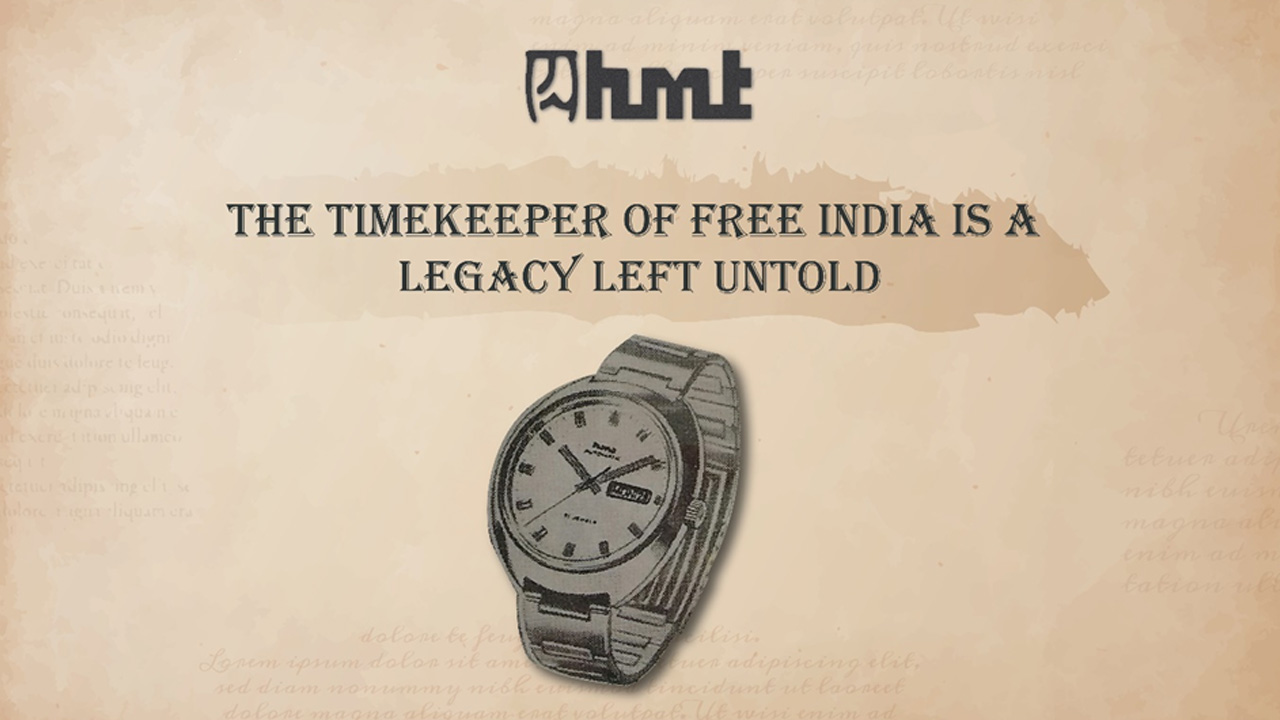As children, one thing we were always taught to understand and acknowledge was the importance of time. Be it an educator at school or someone at home, the wristwatches they adorned always had our fascination till we came to an age where we started using them too! That said, when asked which one was their favourite, the unanimous answer happens to be one brand that ruled the Indian time market and was a must-have in the retro era. HMT watches known for their robust design and sturdy functionality were on the proud-ownership list for the youth then while living up to its tagline – Timekeepers of the Nation.
Regrettably, once a symbol of rapidly industrializing India that made wristwatch an inalienable accessory waned with time. Let’s take a look at the timeline of the rise and fall of one of the largest watchmakers in the world…
1. Global beginnings leading to a legacy
Hindustan Machine Tools (HMT) was officially incorporated in 1953 by the Government of India in Bangalore as a machine tool manufacturing company. Their span of offerings diversified into watches, tractors, heavy machinery such as metal forming press, CNC systems, bearings, and die casting machinery. In 1961, a historic event took place during the liberalisation period, when HMT collaborated with the Citizen watch company of Japan to set up India’s first wristwatch manufacturing facility. This collaboration was a crucial step in HMT’s expansion as the enterprise had deep expertise in heavy machinery, but the micro-engineering that went behind watch manufacturing was new to the Indian market.
2. Time to rule: India’s monopoly
As a prevailing economic policy of the then government which imposed severe restrictions on an imported good, any meaningful competition was thwarted, thereby favouring local production of goods. HMT swiftly rose to hold the iconic watch brand status.
From the mid-1960s to the 1980s, the demand for wristwatches was at its peak, so much so that it made sellers put up waiting lists for certain products which stretched for months. The black-and-white ad slogans Desh ki Dhadkanand Timekeepers to the Nation rang true while grabbing the attention of the people who resonated with its sentiment of ‘Made in India’. In 1991, HMT was reported to produce nearly seven million watches- more than all its rivals combined! Such was its monopoly.
3. Fuelled national consciousness
One of the contributing factors of HMT’s tremendous success was the promotion that captured the essence of national pride and the brand’s continued USPs were precision and accuracy. One of the HMT’s first documentaries that went live in the black-and-white era captures how HMT offered the one essential thing humans work around- the small package of accurate time at affordable prices.
Dedicating its product to the people of India, HMT made a remarkable move when it launched Janata. The most storied, emblematic, and charming watch of all times, HMT Janata represented a collective national dream that filled Indians with pride and united them through a locally-made, reliable product.
4. Robustness and functionality in a budget
The well-thought-out advertising campaigns reflected India’s social and regional diversity with melodious renditions conveying an evergreen message- a timekeeping machine for those who seek functionality in a budget. The watch was designed bearing in mind the rough usage it would be exposed to when Indians used public transport to travel. HMT thus introduced watches that delivered the best customer experience to date- sturdy with minimal cosmetic orientation.
5. Names sculpted in time
That HMT watches were decidedly subdued in design, were essentially unfussy and hardy timepieces is no news. But what also cannot be ignored is how its designs flourished with a simple strategy of personifying Indian identities, giving its model names that looked like desi versions of watches- Janata, Amar, Ajeet, Sanjay, Usha, Vijay, Vikas, Rajat, Kanchan, and whatnot! HMTPilot was the most loved among the Armed forces. While many from the young generation later found love in other international brands that came in, the personalisation that HMT delivered in that era is something that the loyal fans continue to extol.
6. A gift, lucky charm, or legacy to carry forward
Watches have been an evergreen gifting choice for Indians, probably because of the fact that it was considered a status symbol decades ago and the ideology continues. Considered a quintessential gift for all major milestones in life like high school graduation, college graduation, weddings, or family heirloom HMT watches were always affordable and reliable. This vintage ad in a newspaper gives a peek into what drove brand loyalty from the customers irrespective of the age, or region- classic, metallic look, sturdy, water-resistant (new in India), accurate, and something which can be passed on to generations.
7. Market transition: Technology vs Craftsmanship
Having ruled the market as a monopoly for over two decades with its classic mechanical watches, HMT witnessed the global watch industry transition from mechanical to quartz in the mid-eighties. However, the market demand in India remained unaffected as quartz watches were highly-priced then. A couple of years later, when the hitherto import restrictions were lifted, the prices for quartz watches dropped and amidst all this, the Tata group decided to enter the market, with the brand name Titan.
As an enterprise that gathered brand loyalty from customers of various age groups, HMT continued its focus on producing more mechanical watches. The step probably was one of the most notable misses by HMT, as it didn’t realize that the Quartz technology, though relatively expensive, relied on the latest technology rather than craftsmanship.
8. The dawn of decline
In the early 1990s when India opened doors to global brands owing to the liberalisation, Quartz watch became a norm in India. When HMT decided on the continued production of mechanical watches turning a blind eye to the rising fan brigade for Quartz, it somewhere started losing out to the competition. By the time it joined the bandwagon of Quartz, other players like Titan had already established themselves in the market, and in 1994 HMT registered the highest loss in the past five years amounting to 60 crore INR. The lack of innovation became evident in HMT’s offerings when Titan which was in its initial growth phase reflected creativity and innovation through different designs which also captured the interests of the feminine brigade.Ironically, the original timekeeper could not pace up with changing times, and robust and sturdy started losing out to sleek and sophisticated.
9. Inability to leverage digital marketing
Coming to think of it, the effect HMT had on the Indian market was phenomenal. From building a nationwide community of brand loyalists to using the right promotion tactics and grabbing the attention of the consumer- they did it all. However, the lack of market analysis and delay in identifying the changing demand of consumers led to its downfall.
Even in its later years, when it could have captured the interests of the audience through the latest marketing tools, HMT chose to ignore the power of digital marketing and highlight how they are an evergreen choice for those who love vintage and are still a huge fan of robust, sturdy and accurate watches.
Conclusion:
The hallmarks of an excellent consumer business include the ability to identify and change with changing consumer preferences. Understanding the market segments, investing in brand building, position the brand in the correct market segment by innovating the product and last but not the least understanding the product performance and its merits could have made the difference for HMT. Watch Retail stores revamping and designing aligned to the brand, Ecommerce shopping center and digital marketing could have changed the fortunes for the company.The lack of product differentiation that would have rather encouraged HMT’s target audience to continue buying products, was evident when it failed to recognize the expectations of the market; which Titan seemed to have grabbed- the likes of women and children in watches.
While HMT still remains an irreplaceable time-maker in the hearts of many Indians, for most enthusiasts they are keepsakes that have been passed over generation and hold a great sentimental value, and arguably – monetary worth.



